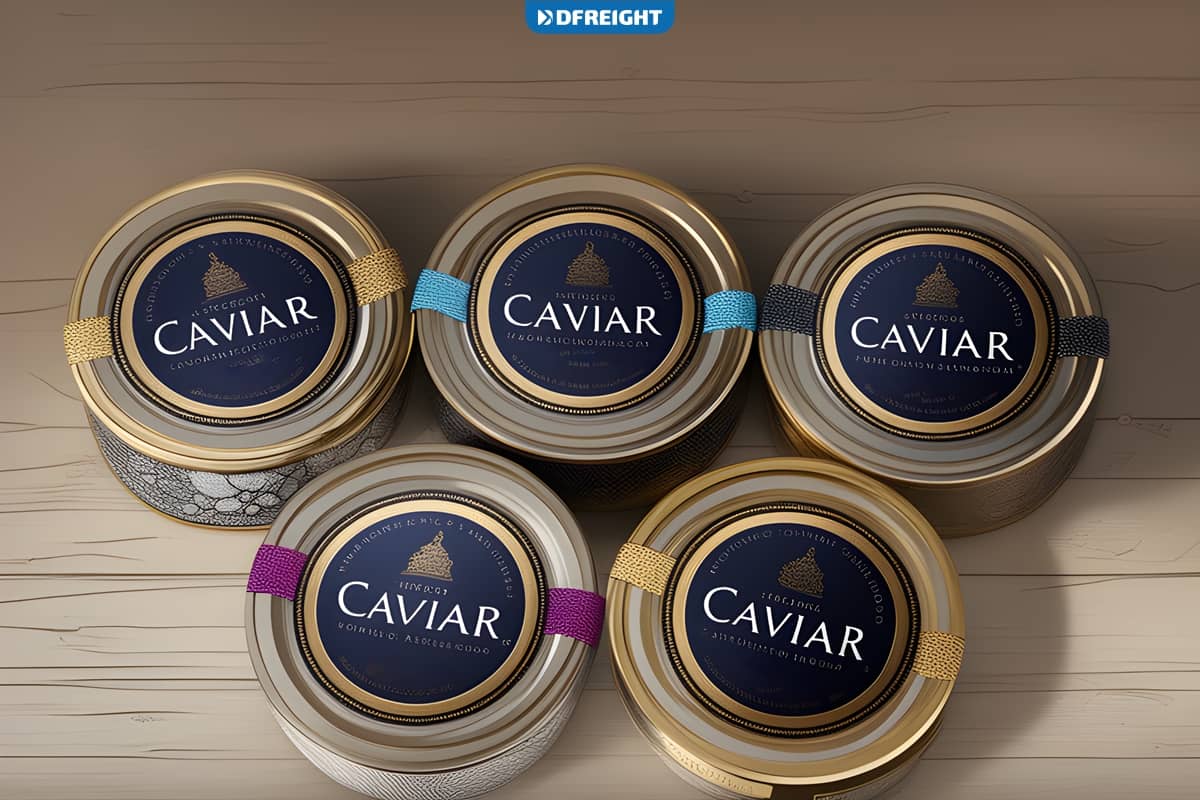Welcome to the comprehensive Guide to Shipping Caviar! In the world of gourmet delicacies, few items evoke the same level of luxury and indulgence as caviar. This guide is your comprehensive resource for mastering the art of shipping caviar, allowing you to savor this exquisite treat no matter where you are. Whether you’re a caviar connoisseur, a business owner catering to upscale clients, or simply someone eager to share the delight of caviar with friends and family, ensuring its safe and proper shipping is crucial to preserving its quality and taste.
Discover the convenience and excellence of shipping caviar worldwide with DFreight, your trusted digital freight forwarder. Our advanced online platform and mobile app streamline the process, ensuring your caviar reaches its destination perfectly. With expertise in temperature-controlled shipping, regulatory compliance, and top-tier carriers, DFreight guarantees a seamless journey for your delicate cargo. Elevate your caviar shipping experience with DFreight—your partner in preserving the essence of luxury, no matter where it’s enjoyed.
Table of Contents
Shipping Caviar
Shipping “black gold” caviar isn’t just about sending a package from point A to point B; it’s about maintaining the delicate balance of flavors and textures that make caviar so unique. Caviar’s perishable nature means it’s sensitive to temperature changes, handling, and transit conditions. Improper shipping can lead to compromised quality, altered taste, or even spoilage, turning a luxurious experience into a disappointing one.
Legal and Regulatory Considerations
When shipping caviar, navigating the legal and regulatory landscape is paramount. Caviar is a highly prized delicacy derived from fish species often subject to international and domestic regulations to preserve their populations and protect the environment.
International and Domestic Regulations
Caviar production involves species like sturgeon, often listed as endangered or protected under international agreements such as the Convention on International Trade in Endangered Species of Wild Fauna and Flora (CITES). CITES regulates the trade of endangered species and their by-products, including caviar. Depending on the species and the country of origin, permits, certificates, and documentation might be required for import and export.
On a domestic level, various countries have their regulations governing the trade and shipping of caviar. These regulations can include harvesting, processing, packaging, and labeling guidelines. Researching and complying with the specific rules of your country and the destination country is crucial to ensure a smooth shipping process.
Permits and Documentation
Before shipping caviar, you may need to obtain permits or certificates that attest to the legality and origin of the product. These documents might include CITES permits, which certify that the caviar was harvested and traded in compliance with international regulations. Health and hygiene certificates might also be required to ensure the caviar meets food safety standards.
Working with government agencies, customs authorities, and shipping carriers will help you gather the necessary permits and documentation. Failing to secure the proper paperwork could result in delays, fines, or confiscation of the shipment.
CITES and Endangered Species Concerns
Given the precarious status of many sturgeon species, CITES plays a vital role in regulating the international caviar trade. The Convention categorizes sturgeon species based on their conservation status, and shipping caviar from certain species might be restricted or prohibited altogether. It’s essential to consult CITES listings and stay informed about any updates or changes that might affect your shipping plans.
In recent years, efforts have been made to promote sustainable caviar production through conservation initiatives and responsible fishing practices. Some caviar producers adhere to strict guidelines to ensure the sustainability of sturgeon populations and the long-term viability of the caviar industry.
Packaging Materials
Proper packaging is the cornerstone of successfully shipping caviar. Caviar’s delicate texture and sensitive flavor require careful consideration when selecting packaging materials. Ensuring that your caviar arrives at its destination in perfect condition relies on using appropriate containers, insulation, and cushioning.
Suitable Containers for Caviar
The container you choose for your caviar is instrumental in preserving its quality. Opt for airtight, leak-proof, and food-grade containers that prevent contamination or air exposure. Glass jars or metal tins are commonly used for packaging caviar, as they offer the necessary protection and maintain a consistent temperature.
Clear containers with secure lids allow easy inspection while minimizing the need to open the package. This is particularly important when dealing with customs and security checks during shipping.
Insulation and Temperature Control
Maintaining a stable temperature during transit is vital to prevent caviar spoilage. You must include appropriate insulation materials depending on the shipping method and the distance involved. For shipments that require temperature control, consider using insulated packaging liners or boxes to help regulate the internal temperature.
When shipping perishable items like caviar, it’s advisable to use temperature-controlled shipping services that offer refrigeration or cold storage options. This ensures that your caviar remains at the optimal temperature throughout its journey.
Cushioning and Protection
Caviar is delicate, and rough handling can compromise its texture and flavor. Use cushioning materials such as bubble wrap, packing peanuts, or air pillows to create a protective barrier around the containers. Ensure the caviar containers are securely nestled within the packaging and can’t move around during transit.
Avoid excessive cushioning that could lead to pressure on the caviar containers, and balance the need for protection with the requirement to minimize the weight of the package.
Additional Tips
- Place the caviar containers in a secondary, sealed plastic bag for added protection. This provides an extra layer of security against leaks and spills.
- If using dry ice for temperature control, follow proper guidelines for handling and packaging dry ice to prevent any hazards.
- Label the package as “Perishable” or “Fragile” to alert shipping carriers to handle it carefully.
- Include a packing slip or note that outlines the contents and any special handling instructions, including the need for refrigeration.
Temperature Control and Perishability
Maintaining the right temperature is paramount when shipping caviar, as its delicate nature makes it highly sensitive to temperature fluctuations. The perishable nature of caviar necessitates meticulous attention to temperature control throughout the shipping process.
Importance of Temperature during Shipping
Caviar’s exquisite flavor and texture can be compromised by exposure to temperature extremes. Excessive heat can cause the caviar to spoil while freezing temperatures can negatively impact its delicate roe. Maintaining a consistent, cool temperature throughout transit is essential for preserving caviar’s quality.
Dry Ice vs. Gel Packs: Choosing the Right Cooling Method
When shipping perishable goods like caviar, two common cooling methods are dry ice and gel packs. Each method has its advantages and considerations:
- Dry Ice: Dry ice is solid carbon dioxide that sublimates (turns into gas) as it melts, providing consistent cooling. It’s ideal for long-distance shipments or when extended cooling is required. However, it’s essential to be cautious when using dry ice, as it can be hazardous if not handled properly. Follow safety guidelines for packing, handling, and labeling.
- Gel Packs: Gel packs are pre-frozen packs filled with gel or a similar substance that maintains a low temperature for a specific duration. They are easier to handle and less hazardous than dry ice. Gel packs are suitable for shorter shipping distances and situations where milder cooling is sufficient.
Monitoring and Tracking Systems
To ensure that your caviar remains at the desired temperature throughout its journey, consider using monitoring and tracking systems. Some advanced shipping carriers offer temperature-controlled shipping services that provide real-time tracking of temperature conditions. These systems can alert you to deviations from the optimal temperature range, allowing you to take immediate action if needed.
Proper Packing Techniques
When using cooling methods like dry ice or gel packs, it’s essential to pack them appropriately to avoid direct contact with the caviar containers. Place a barrier, such as an insulating layer, between the cooling agents and the caviar to prevent freezing or uneven cooling.
Shipping Methods
Selecting the appropriate shipping method is crucial in ensuring that your caviar reaches its destination in optimal condition. The choice of shipping method can impact the speed, cost, and overall quality of the delivery.
Overnight vs. Expedited Shipping
For perishable items like caviar, expedited shipping methods are highly recommended. Overnight shipping, also known as next-day delivery, is particularly well-suited for caviar due to its need for quick and consistent transit. Overnight shipping ensures the caviar spends the least time in transit, reducing the risk of temperature fluctuations and spoilage.
Expedited shipping options, such as two-day or three-day delivery, can also be suitable depending on the distance and specific shipping carrier’s capabilities. However, the faster the shipping, the higher the cost is likely to be.
Choosing a Reliable Shipping Carrier
Selecting a reputable and reliable shipping carrier is essential to the success of your caviar shipment. Look for carriers that specialize in perishable goods and offer temperature-controlled shipping options. Some carriers have experience handling delicate items like caviar and provide specialized packaging and handling procedures to ensure the products remain fresh during transit.
International Shipping Considerations
If you’re shipping caviar internationally, there are additional factors to consider. International shipments involve customs procedures, import/export regulations, and potentially longer transit times. It’s essential to research the destination country’s rules and provide all necessary documentation to facilitate a smooth customs clearance process.
Consider using a shipping carrier with expertise in international shipping and a network of reliable partners in different countries. They can guide you through the necessary paperwork and procedures to ensure your caviar reaches its international destination without complications.
Labeling and Documentation
Proper labeling and documentation are essential when shipping caviar to ensure your package complies with regulations, clears customs smoothly, and reaches its destination without delays. Accurate labeling and thorough documentation help convey important information about the contents, handling requirements, and legal compliance.
Required Labels and Markings
Proper labeling provides crucial information to shipping carriers, handlers, and customs authorities. Key labels and markings to consider include:
- Perishable Label: Mark the package as “Perishable” or “Fragile.” This alerts handlers to handle the package carefully and prioritize its swift transit.
- Temperature Requirements: If the caviar requires specific temperature conditions, indicate this on the label. For example, if using dry ice, label the package with “Dry Ice” and specify the type and quantity.
- Contents Label: Provide a clear description of the contents. Use a label that specifies “Caviar” along with the specific type, if applicable (e.g., “Beluga Caviar”).
- Sender and Recipient Information: Include complete contact details for both the sender and the recipient. This ensures that the package can be traced and delivered accurately.
Customs Declarations and Forms
For international shipments, customs documentation is crucial. Be prepared to fill out customs declarations and other required forms accurately and completely. Key documentation includes:
- Commercial Invoice
- Certificate of Origin
- CITES Permits
- Health and Hygiene Certificates
Insurance Options
Consider insuring the shipment to protect against loss, damage, or spoilage during transit. While carriers take precautions, unforeseen circumstances can arise. Insuring the shipment adds an extra layer of security, particularly for high-value items like caviar.
Communication and Recipient Instructions
Include clear instructions for the recipient on handling the caviar upon arrival. Guide unpacking, storing, and refrigerating the caviar to maintain its quality. It’s also helpful to communicate the expected delivery date and any tracking information.
Troubleshooting Common Issues
Even with careful planning, unforeseen challenges can arise when shipping caviar. Shipping delays due to weather, customs clearance issues, or temperature fluctuations can impact the quality of the delicate cargo. In such cases, prompt communication with the shipping carrier and the recipient is crucial. Stay informed about the package’s progress using tracking systems, and be prepared to guide how to handle the caviar if delays occur.
Having contingency plans, such as using additional cooling materials or addressing customs documentation concerns swiftly, can help mitigate potential problems and ensure that the caviar’s exceptional taste and texture are preserved upon arrival.
Shipping Caviar Worldwide with DFreight
When shipping caviar, ensuring its exquisite taste and quality reach global destinations intact demands a freight forwarder with expertise, efficiency, and a commitment to excellence. DFreight stands out as the ultimate choice for shipping caviar worldwide, offering an innovative online platform and mobile app that streamline the shipping process while maintaining the highest standards of care.
With years of experience in freight forwarding, DFreight understands the unique requirements of shipping perishable goods like caviar. Leveraging cutting-edge technology and a user-friendly interface, DFreight’s online platform allows you to seamlessly initiate and manage your caviar shipments from the comfort of your device. The mobile app enhances convenience, keeping you informed about the status of your shipment in real-time and enabling quick responses to any potential issues.
DFreight’s expertise extends to understanding the delicate nature of caviar. The platform provides tailored solutions for temperature-controlled shipping, ensuring your caviar remains at the optimal temperature throughout its journey. From selecting the appropriate packaging materials to coordinating with reliable carriers, DFreight’s meticulous attention to detail safeguards the freshness and flavor of your caviar, no matter how far it travels.
What sets DFreight apart is its commitment to a seamless and transparent shipping experience. The platform assists you in preparing accurate customs documentation, adhering to regulations, and addressing any unexpected delays that might arise during transit. Their team of experts is readily available to provide guidance and support, ensuring that your caviar shipment clears customs without a hitch.
Shipping caviar with DFreight means more than just logistics; it guarantees a premium and hassle-free experience. Your dedication to providing the finest caviar is matched by DFreight’s dedication to delivering it in pristine condition to discerning customers worldwide. Trust DFreight as your partner in shipping caviar, and elevate the experience of savoring this delicacy wherever it may travel.

Conclusion
In the world of luxury and gourmet delicacies, shipping caviar demands a blend of precision, expertise, and care. This guide has provided an extensive understanding of the nuances of successfully shipping caviar, from selecting the finest quality and packaging materials to navigating legal considerations and temperature control.
By following the guidelines presented here, you’re equipped to preserve caviar’s exceptional taste, texture, and essence throughout its journey, whether it’s destined for local clients or international enthusiasts. From selecting the appropriate shipping methods to ensuring proper documentation, you’re now prepared to navigate every step of the shipping process with finesse.
Remember, shipping caviar isn’t just about logistics; it’s about delivering an unparalleled culinary experience to those who appreciate the finer things in life. With attention to detail, dedication to quality, and the right shipping partner, you can ensure that caviar lovers worldwide can savor this delicate delight at its best, no matter where they are.
Can caviar be shipped internationally?
Yes, caviar can be shipped internationally. However, due to its perishable nature and international regulations, there are specific guidelines to follow. Ensure you have the necessary permits, comply with import/export regulations, and work with experienced freight forwarders who understand international shipping requirements for caviar.
How do I handle unexpected caviar shipping delays?
Shipping delays can occur due to weather, customs, or other unforeseen circumstances. In case of delays, ensure the caviar remains within the specified temperature range. Communicate with the recipient to provide updates, reassurance, and guidance on proper handling upon arrival. Always maintain a line of communication with your shipping carrier to address any issues promptly.
Should I insure my caviar shipment?
Insuring your caviar shipment is recommended, especially for high-value items. While reputable carriers take precautions to maintain quality, unforeseen incidents can occur. Shipping insurance helps protect your investment against potential loss, damage, or spoilage during transit. Consult with your chosen carrier about insurance options that suit your needs.
Can I use regular packaging for shipping caviar?
No, using regular packaging for shipping caviar is not recommended. Caviar’s delicate nature requires specialized packaging to maintain its quality. Choose airtight, leak-proof containers with proper insulation and cushioning to prevent temperature fluctuations and physical damage. Packaging designed for perishable goods ensures the caviar arrives in the best possible condition.
What is the best way to track my caviar shipment?
The best way to track your caviar shipment is through the tracking systems provided by your chosen freight forwarders. Reputable freight forwarders like DFreight offer online tracking tools that allow you to monitor your package’s journey in real time. You’ll receive updates on its location and estimated delivery time. By using these tracking systems, you can stay informed and address any issues promptly to ensure a successful delivery.














